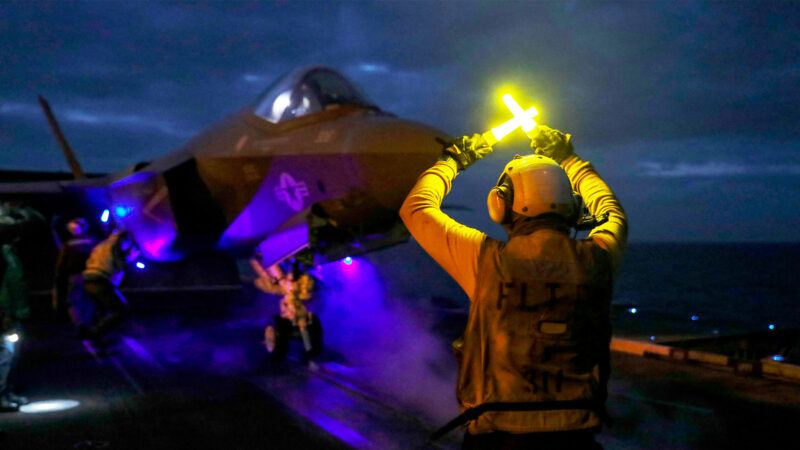The $1.7 Trillion F-35 Fighter Jet Program Is About To Get More Expensive
GAO: Congress has been buying planes that lack crucial parts and haven't undergone full testing, so costly upgrades will eventually be needed.

Construction of America's newest fighter jets is running over budget and behind schedule—and despite the delays, the finished jets are likely to need costly upgrades because some parts won't be finished until 2029.
A new Government Accountability Office (GAO) report, released Monday, is the latest black mark for the Pentagon's F-35 fighter jet program, which is already pegged to cost taxpayers more than $1.7 trillion over the planned life of the aircraft. But the military's most expensive toys might be getting even costlier because the Pentagon is pressing ahead with purchasing the planes before operational testing of all components is complete, primarily due to holdups in developing a flight simulator.
"The more aircraft produced before testing is complete, the more it might cost to retrofit those aircraft if issues are discovered," GAO auditors warn. If the Pentagon "moves forward as planned, it will have bought a third of all F-35s before determining that the aircraft is ready to move into the full-rate production phase."
Other "crucial hardware and testing upgrades" for the new jets are now expected to be in development until 2029, according to the audit. That means any jets already completed or being built will likely require expensive upgrades later on.
Overall, the GAO says it has identified 826 "open deficiencies" in the F-35 fighter program, including four problems that are categorized as potentially jeopardizing the safe operation of the aircraft. Those include "issues with the night vision camera and cabin overpressurization." At the rate F-35s are currently being completed and delivered, more than 1,100 jets could be delivered before operational testing is complete, meaning they could require future upgrades before being cleared for military use. And jets that have already been deployed for use "are not performing as well as expected."
The GAO notes that it would be more cost-efficient to hold off on buying F-35s until they are operationally tested than it would be to pay for the aircraft now and upgrade them later.
But, of course, when did cost efficiency and the military go hand-in-hand? There's a reason Lockheed Martin brags about building parts of the F-35 in 48 different states, and that's not because it saves money. The F-35 has been as much an expensive make-work program for military contractors as it has been a vital part of America's national defense—and in that regard the cost overruns and eventual upgrades might be seen as a feature rather than a bug.
Production of the F-35 fighter was originally supposed to cost about $200 billion, but the price tag has already ballooned to about twice as much. Recently, Lockheed Martin warned that supply chain issues and inflation could cause further delays and cost overruns. Monday's GAO report confirmed that construction is running behind schedule, with about 28 percent of the 553 completed jets having been delivered late.
President Joe Biden's fiscal year 2023 budget calls for the purchase of another 61 F-35s to be used by the Air Force, Navy, and Marines. That's down from last year's total of 85 F-35 jets, according to Defense One, a military contractor trade publication. And it is about one-third fewer than the 94 F-35s that were planned to be purchased this year, according to last year's federal budget.
Trimming the purchases seems like a wise move in light of Monday's audit. Dan Grazier, a senior defense policy fellow at the Project on Government Oversight (POGO), a fiscally conservative nonprofit, points out that buying any F-35s before operational testing is complete puts taxpayers and troops at risk.
Based on the most recent Pentagon estimates, Grazier writes that Biden's decision to cut 33 jets from next year's order could save $84 million "because of upgrades that will not be needed."
Of course, some members of Congress are already pushing to buy even more of the incomplete fighter jets. Politico reported last month that the effort is being led by Reps. John Larson (D–Conn.), Mike Turner (R–Ohio), Marc Veasey (D–Texas) and Chris Stewart (R–Utah). All four, Grazier points out, represent districts where Lockheed Martin is manufacturing F-35s or where fighter jet maintenance facilities are located.
Sure, taxpayers will end up on the hook for avoidable and expensive future upgrades to the F-35 fleet. But, hey, those defense contractor jobs aren't going to create themselves.

Show Comments (81)